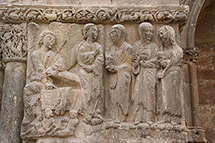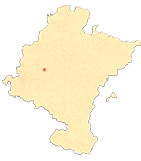La Portada de San Miguel de Estella
Relief of the three Marys before Christ's tomb
On the other side of the door are two other slabs which this time form a single scene: the visit of the three Marys at the empty tomb of Christ on Easter morning. On the left is the sarcophagus on which an angel is seated, with one of those impossible leg crossings so common in Romanesque art. He lifts the lid while pointing towards the sheet peeping over the edge. Standing before the sarcophagus is a second angel, who raises his right hand to show that he is speaking to the three women. What he says to them is written on the tomb: SURREXIT NON EST HIC, i.e. "He is risen, he is not here", four of the words spoken by the angel according to the Gospel of Mark. Under the sarcophagus lie two soldiers of the guard, asleep.
The women appear on the other slab. The composition is reminiscent of the capital of the Magi, as it adopts one of the usual solutions for conferring a certain animation to a sequence of three people. The first Mary looks at the standing angel, holding up her right palm as a sign of attention. The second turns her gaze towards the third, who is looking straight ahead. There are thus two dialogues of gazes. The resemblance extends to the shape of the perfume bottles, cups with curvaceous lids. Slight gestures animate the group: the half-open hand of the second contrasts with the third, who is holding the edge of the cloak. Under their feet, the registration identifies them: MARIA MAGDALENA MARIA IACOBI ET ALTERA MARIA, a detail which differs from Mark's text, for which the third woman is called Salome. Without a proper name, simply as Mary, she appears in Matthew's Gospel, in which only two women go to the tomb and a single angel gives them the news. In Mark there is also an angel waiting for them, while there are two men in shining garments in Luke's account, for whom the third woman was called Joanna, although there were others whom he does not specify. From all this we can deduce that the relief does not follow a specific Gospel narrative, but accumulates details from several.
The choice of topic is due to the idea of placing before the eyes of the spectators the crucial moment of the passage of Jesus Christ on earth: his Resurrection, without which the Christian faith would be nothing, according to Saint Paul. And it reinforces the idea expressed in the registration of the mandorla: that Jesus was man, because he died and was buried, and God, because he rose from the dead.











